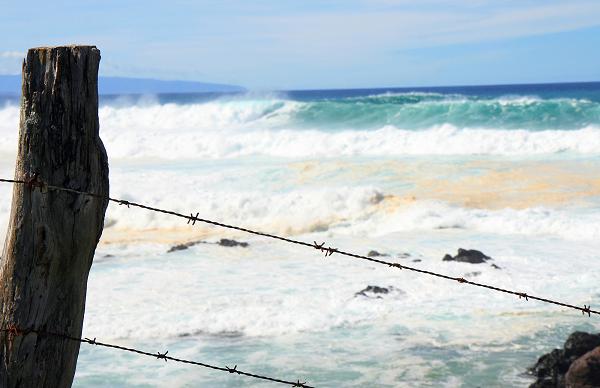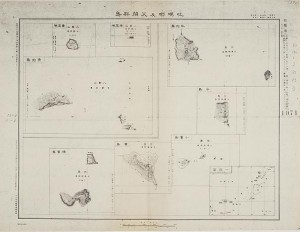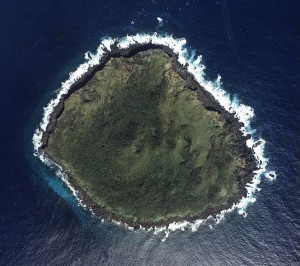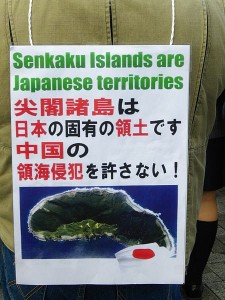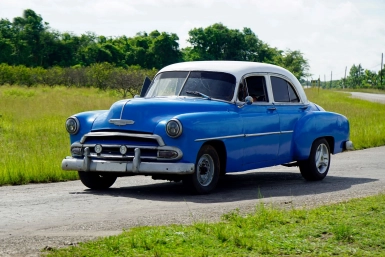In an essay entitled Senkaku Islands: A Historical Perspective, Japan based writer Stack Jones gives us a background into the territorial dispute as well as some of his opinions about the turmoil in the region.
The Senkaku Islands are a chain of eight small islets at the center of a long territorial dispute that exists between China and Japan. The islands are known in Japan as Senkaku, Diaoyu in China, and Tiaoyutai in Taiwan; the uninhabited archipelago is located in a gas rich region that is also believed to contain large oil reserves. The area is also surrounded by rich fishing waters, and has a landmass of approximately six square kilometers.
After the Second World War, a civil war was fought for control of China between the Chinese Nationalists, led by Chiang Kai-shek, and the Chinese Communist Party, led by Mao Zedong. By 1949, the Chinese Communist Party had defeated Chiang’s Nationalist army on the mainland. Chiang and his supporters fled to Taiwan, making Taipei the “temporary” capital of the Republic of China.
As a result of China’s “ongoing” civil war, the Republic of China claims to be the legitimate government. Taiwan’s territorial claim includes sovereignty over China’s mainland, Mongolia, and all other territories controlled by China’s communist regime, including the islands known as Tiaoyutai.
The dispute between Japan and China is a long one that has often strained relations between the two countries. Japan claims that China only became interested in the islands when natural gas, and possible oil reserves, were uncovered. However, the disagreement over sovereignty existed long before the 1969 United Nations Economic Commission for Asia and the Far East discovery of natural gas deposits around the small islets chain.
Territorial Dispute. A Snowballing Fiasco
China claims the islands have been part of its territory since the 14th century. Chinese maps that date back to the Ming Dynasty support proof of this claim. Beijing officials are quick to argue that Chinese fishermen have used the islands since ancient times.
Japan claims it discovered the islands in 1884 and annexed them in 1895 after winning the First Sino-Japanese War. China rejects Japan’s claim, arguing that it was forced to sign the post-war treaty after Japan invaded the mainland.
Japan had control of the islands until the end of the Second World War, after which the defeated nation signed the San Francisco Peace Treaty, which gave Washington temporary control of the islands.
Forty-eight nations attended the conference but China wasn’t invited, did not attend, and therefore does not recognize the Treaty of San Francisco. China had not attended the conference because it was in the throws of a civil war between the Republic of China Nationalists and the People’s Republic of China’s Communist Party.
Clause 14 of the San Francisco Peace Treaty allowed Allied forces to confiscate all assets owned by the Japanese government, Japanese corporations and Japanese organizations, and any property owned by Japanese private citizens.
Clause 14 land seizures included all colonized, or occupied countries that had been in Japan’s control. Clause 21 of the article gave China exclusive authority over all Japanese assets located in Manchuria, and Mongolia.
The San Francisco Peace Treaty officially renounced any of Japan’s rights that had been derived from the Boxer Protocol of 1901, and any of the nations claims to Korea, Formosa (Taiwan), Hong Kong, the Pescadores, the Kuril Islands, the Spratly Islands, Antarctica and Sakhalin Island in the North Pacific.
Article 3 of the treaty left the Bonin Islands and the Ryukyu Islands, which included Okinawa and the Amami, Miyako and Yaeyama Islands, under a US trusteeship.
On December 25th, 1953, the Amami Islands were returned to Japan. On April 5th, 1968, the Bonin Islands were returned to Japan’s control. In 1969, the US authorized the transfer of authority over the Ryukyus to Japan, an order which was to take effect in 1972. In 1972, the US reversion of the Ryukyus occurred along with the ceding of control over the nearby (uninhabited) Senkaku Islands.
Both the People’s Republic of China and the Republic of China argue that this agreement between Japan and the US had not considered the ultimate sovereignty of the Senkaku Islands prior to turning control over to Japan.
Since the early 70s, minor skirmishes between China and Japan have broken out over the territorial claims.
With China’s growing demand for oil, and world reserves declining, no doubt the discovery of gas, and possible oil reserves are what lies beneath the recent clashes. Until recently the disputes had been minor, and existed merely between fishing vessels from the two countries.
In 2010, a serious diplomatic episode developed after Japan arrested the captain of a Chinese fishing boat when it collided with a Japanese coast guard vessel near the islands. Japan eventually released the captain, but only after Beijing postponed bilateral talks, and suspended some trade.
Although the US does not have an official position on the merits of the competing sovereignty claims, the islands are included within the US-Japan Security Treaty. This means that Japan may compel support from the US military to help defend security of the islands.
More recently, Tokyo’s controversial mayor, Shintaro Ishihara, offered to purchase the disputed islands with public funds. Ishihara’s proposal included the construction of concrete structures Ishihara says would safeguard fishermen if a typhoon were to approach the islands.
This ploy sparked outrage from Chinese authorities who are utterly opposed to the building of any structure on the pristine islands. It must be noted that Japan’s coastlines, which are 70% covered in appalling, and poorly designed concrete structures, are for me, the most aesthetically unpleasing to be found any where in the world. The building of such structures would no doubt provoke China to take strong measures against Japan.
In August of 2012, Japan arrested fourteen Chinese activists who planted a flag on the islands. The protesters were released after being detained for two days. Later that same month, at least two people were involved in taking the Japanese flag from Uichiro Niwa, the ambassador of Japan’s vehicle, as he was returning to the Japanese Embassy in the Beijing.
Earlier this month (September 2012) it was reported that Japan’s central government had purchased the three of the eight islands for 2.05 billion yen. Hong Lei of China’s Foreign Ministry said his country has been closely following the issue, and has vowed to take necessary measures to protect its territorial sovereignty, including bringing the matter to the world court. China, Taiwan, Korea, and Russia are strongly opposed to Japan’s position, and as a result, this could probably cost Japan its bid for the 2020 Olympics.
Most recently the People’s Republic of China has allowed front-page photos of Chinese citizens protesting Japan’s control over the islands. Protests are increasing across China over the islands issue. As of September 2012, China has dispatched military vessels to the Senkaku region. Taiwan has sent ships as well.
As of September 15th there has been five straight days of anti-Japan rallies, which are growing in size, and number daily. Many protests have been organized via the internet. Angry crowds have destroyed Japanese made cars, ransacked Japanese restaurants and vandalized chains such as Jusco, and Heiwado. Protestors shout slogans such as, “Slap economic sanctions on Japan.”
The scale of the protests is the largest between the two nations since diplomatic relations normalized in 1972.
Evidentiary Claims Of Ownership To The Island Chain
According to China, the islands were under their control since 1372, and it had referred to the islands as part of Chinese territory since 1534. China claims control of the Taiwan, and the Senkaku Island as early as the Qing Dynasty. The earliest written record of Diaoyutai dates back to 1403 in a Chinese book, Voyage With The Tail Wind, which recorded the names of the islands that voyagers had passed on a trip from Fujian to the Ryukyu Kingdom.
By 1534, all the major islets of the island group were identified and named in the book Record of the Imperial Envoy’s Visit to Ryukyu, and were the Ming Dynasty’s (16th-century) sea defense frontier. One of the islands, Chihweiyu, marked the boundary of the Ryukyu Islands. This is viewed by both China, and Taiwan as meaning that these islands did not belong to the Ryukyu Islands.
In 1785 a Japanese map called, Sangoku Tsuran Zusetsu was designed by Hayashi Shihei. He adopted the Chinese kanji (Diaoyutai) to annotate the Senkaku Islands, which were painted in the same color as China.
Following the Meiji Restoration, the Japanese government annexed what was known as the Ryukyu Kingdom as Okinawa Prefecture in 1879. The Senkaku Islands, which lay between the Ryukyu Kingdom and the Qing Empire, became the Sino-Japanese boundary.
In 1885, the Japanese governor of Okinawa, Nishimura Sutezo petitioned the Meiji government to take control of the islands. However, Inoue Kaoru, the Japanese Minister of Foreign Affairs, commented that the islands were near the border of the Qing Empire, and that the islands had already been given Chinese names. Inoue was concerned that if Japan proceeded to erect a landmark stating its claim to the islands, it could stir up a conflict with the Qing Empire. Following Inoue’s advice, Yamagata Aritomo, the Minister of the Interior turned down the request to incorporate the islands.
On January 14th 1895, during the First Sino-Japanese War, Japan incorporated the islands, stating that it had conducted surveys since 1884, and that the islands were no man’s lands. Japan took the position that there was no evidence the islands had ever been under the Qing Empire’s control.
After China lost the First Sino-Japanese War, both countries signed the Treaty of Shimonoseki in April 1895 that stipulated, among other things, that China would cede to Japan the island of Formosa (Taiwan) together with all islands belonging to it. The treaty would later be nullified when Japan lost the Second World War, and signed the Treaty of San Francisco, which nullified all prior treaties.
Disagreements Over Sovereignty
There is a disagreement between the Japanese and Chinese governments as to whether the Senkaku Islands were ever part of the islands belonging to Formosa. China and Taiwan dispute Japan’s claim by citing Yamagata Aritomo’s decision to turn down the request to incorporate the islands in 1885. Today, both Taiwan and China assert sovereignty over the islands.
China and Taiwan first made their territorial claims during the 1970s after a 1968 study showed that oil reserves might be found under the sea near the Senkaku Islands. The two countries argue that the sovereignty dispute is a legacy of Japanese invasion of China, complicated by the civil war between the Chinese Communist Party, and the Kuomintang over control of China. Both countries argue that early recordings found in numerous maps prove their claims.
The islands were also used by China as offshore defenses against Japanese pirates during the Ming and Qing dynasties (1368-1911). A Chinese map of Asia, and a map compiled by a Japanese cartographer in the 18th century, also show the islands belong to China.
Further proof offered by China, and probably the strongest, that the Senkaku Islands belong to it is supported by the Potsdam Declaration, which announced the terms for Japan’s surrender, and stated that Japanese sovereignty shall be limited to the islands of Honshu, Hokkaido, Kyushu, Shikoku and such minor islands as “we” determine.
The “we” referred to the victors of the second world war that had attended the Potsdam Declaration. The participants were the US, the UK, and the Republic of China. It must be noted that Japan accepted the terms of the declaration when it surrendered. The declaration included strong language, warning, “We will not deviate from them. There are no alternatives. We shall brook no delay.”
Today, Japan takes the position that the islands had been uninhabited and showed no trace of having been under the control of China prior to 1895. Japan also claims the islands were neither part of Taiwan nor part of the Pescadores Islands, which were ceded to Japan by the Qing Dynasty of China in Article II of the May 1895 Treaty of Shimonoseki, thus were not later renounced by Japan under Article II of the San Francisco Peace Treaty. Japan also states that the US, between 1945 and 1972, controlled the islands and after the occupation, Japan exclusively exercised administration over the islands.
Japan also alleges that China and Taiwan only started claiming ownership of the islands in 1971, following a 1969 United Nations report that large oil and gas reserves may exist under the seabed near the islands. Japan further claims that former president of Republic of China, Lee Teng-hui, said that the Senkaku Islands are part of Okinawa.
Japan erected a marker on Kubajima and Uotsurijima to incorporate the islands as part of its territory. This was widely publicized in 1950. Koga Tatsushiro and his family then “developed” four of the islands with permission from the Japanese government.
Kentaro Serita of Kobe University points out that an official history book called the History Of Ming compiled during the Qing Dynasty, describes Taiwan as a foreign country.
After a number of Chinese were rescued from a shipwreck in 1920, a letter purportedly sent to Japanese fishermen by the Chinese Consul Feng Mien in Nagasaki on behalf of the Republic of China on May 20, 1921, made reference to Senkaku Islands, Yaeyama District, Okinawa Prefecture, the Empire of Japan. The letter is on exhibition at Yaeyama museum.
From 1895 to 1940, there was a Katsuobushi factory that had employed approximately two hundred Japanese residents on the islands.
In 1953, the People’s Daily, a newspaper that is controlled by the Central Committee of the Communist Party of China published an article that stated the Senkaku Islands were part of Japan’s territory. In November of 1958, a World Atlas published by the Map Publishing Company of Beijing, treated the Senkaku Islands as Japanese territory.
In 1969, The Washington Times claims it obtained a classified map made by the People’s Republic of China map authority listing the Senkaku Islands as part of Japan’s territory.
In October of 1965, a World Atlas published by the National Defense Research Academy and the China Geological Research Institute of Taiwan records the Diaoyu Islands with Japanese names: Gyochojima, Taishojima, and Senkaku Gunto. In the late 1970s, the government of the Republic of China tried to recall these books, but the information was already available to interested sources.
In 1970, a state-prescribed Taiwan textbook treated the islands as Japanese territories.
In 1978, a Japanese nationalist group, Nihonseinensha built a lighthouse on Uotsuri Jima, which was subsequently handed over to the Japanese government in 2005.
Conclusion. Japan’s Actual Issues Undermined
Whatever the outcome of this long, ongoing dispute there is one thing for certain, Japan’s untimely publicizing, and arranging of the islands purchase, has done nothing but cause turmoil around the region, and I believe it is unwise.
Japan has not acted properly with its looming triple disaster. What has the Japanese officials done with all the charity money it has received for the victims of the earthquake, tsunami, and the nuclear disaster? There are still more than 340,000 people living in makeshift shelters, and the residents of Fukushima are very vocal that the local, and central government has failed miserably in handling the matter.
In Fukushima about 114,000 people are forced to live in 52,000 temporary housing units. It seems logical that Japan would benefit much better if it spent 2.05 billion yen on cleaning up its own mess, before stirring up another one between neighboring nations.
Japan has major economic woes with mounting unpaid debts. Having a good relationship with China, the world’s second economy is paramount to Japan’s recovery.
Alienating China, and provoking the nation over trivial matters such as the Senkaku Islands will only damage Japan in the long run. One example is the probable loss of the 2020 Olympics, which would cost the rebuilding nation multiples of billions of much needed yen in revenue. The Olympics in Japan would also help promote tourism, an industry that has plummeted since March 11, 2011.
Another serious issue is in Japan’s import requirements of China’s rare earths. If China’s measures against Japan would include the suspension of such trade, this would bring about even more dire consequences for a nation that already has immense mountains to climb.
The Senkaku Islands have been around forever. They’ll be around for a long, long time to come. Both nations fish the waters, and both enjoy those benefits. The timing of Japan’s actions, and its implications regarding the Senkaku Islands are troublesome. In the long run, the taking of possession of a few uninhabitable islands that may, or may not have energy reserves, will only hurt Japan.
The writer’s opinions can be discussed and debated on the comments thread, below. His website is here.

